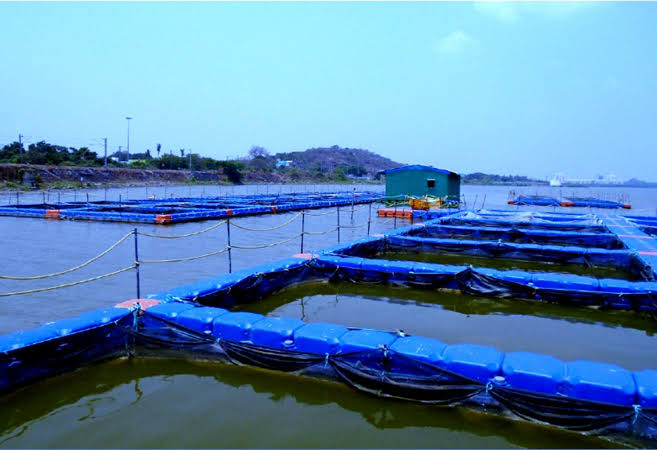Aquaculture, the practice of cultivating aquatic organisms in fish farming has witnessed remarkable growth in recent years. With declining wild fish stocks due to over-fishing, aquaculture has emerged as a crucial solution to meet the increasing demand for fresh fish. This article explores the ever-changing face of aquaculture, highlighting recent advances and new species that are shaping the industry worldwide, including the thriving aquaculture sector in Pakistan. These advancements not only improve production efficiency and product quality but also contribute to the sustainability of the industry.
Biotechnology has revolutionized aquaculture by enhancing reproduction and early development success of cultured organisms. It offers potential avenues for improving the reproductive success and survival of endangered species, contributing to the conservation of aquatic biodiversity. By utilizing biotechnological tools, researchers can extend the availability of gametes and fry, enabling more efficient aquaculture practices.
The emergence of new diseases in aquaculture has raised concerns regarding their impact on the industry. Conventional disease control methods often prove ineffective against novel pathogens, particularly viruses. Therefore, molecular techniques have gained prominence in pathogen screening and identification. These molecular tools enable rapid detection and monitoring of diseases, facilitating early intervention measures and minimizing economic losses in aquaculture operations.
Innovative feed technologies play a crucial role in advancing aquaculture sustainability. With a growing need to reduce reliance on fishmeal, researchers have explored alternative protein sources, particularly plant-based options. By enhancing production and processing techniques, these new technologies offer opportunities for developing sustainable and nutritionally balanced feeds, ensuring the optimal growth and health of cultured species while reducing the pressure on wild fish stocks.
Closed-circulation systems have emerged as a significant development in holding technology for aquaculture. These systems show great potential for reducing fishmeal consumption compared to open field farming, minimizing environmental impacts. Additionally, temporary holding of fish has gained attention as a means to improve meat quality before reaching the market. By providing optimal conditions and controlled environments, these advancements enhance product quality and consumer satisfaction.
The introduction of new species in aquaculture is driven by factors such as existing culture technology, market demand, and anticipated profitability. Farmers seek quick profits by focusing on species that can be mass-produced using existing technologies and have proven market demand. For instance, Tilapia (Oreochromis mossambicus and O. niloticus), Pangasius, African Catfish, and Shrimps have gained significant popularity in aquaculture.
Ranching programs, aimed at releasing cultured organisms into the wild for harvest, have gained improved success rates. This technique has expanded to new areas and targeted new species, benefiting both conservation efforts and fishing communities. Many countries have initiated stock enhancement projects for various species, aiming to restore depleted stocks and enhance biodiversity.
While the emphasis on biotechnology in aquaculture continues to grow, it is essential to ensure responsible technology transfer. This means considering the protection of wild aquatic diversity and potential impacts on rural and subsistence populations. The integration of biotechnology should align with goals of food security, poverty alleviation, and income generation, promoting sustainable and equitable development.
Aquaculture is rapidly evolving and holds tremendous potential to meet the growing demand for fish while reducing pressure on wild stocks. Through innovations in reproduction, disease management, feed technologies, holding systems, and the introduction of new species, the industry is becoming more sustainable and efficient. It is imperative to continue developing these technologies responsibly, keeping in mind the protection of biodiversity and the welfare of local communities. By embracing these advancements, aquaculture can play a vital role in ensuring a secure and sustainable future for global fisheries.
In addition to the advancements discussed above, several other notable developments have emerged in the aquaculture industry. These include the application of genetic technologies, such as selective breeding and genetic modification, to enhance desirable traits in cultured species. Through selective breeding programs, researchers can improve growth rates, disease resistance, and other important characteristics, leading to more productive and resilient aquaculture stocks.
Furthermore, the integration of data-driven technologies and automation systems has significantly improved the monitoring and management of aquaculture operations. Remote sensing, real-time monitoring, and automated feeding systems enable farmers to optimize production conditions, minimize environmental impacts, and reduce resource waste. These technological innovations not only enhance efficiency but also contribute to the overall sustainability of the industry.
The development of integrated multi-trophic aquaculture (IMTA) systems is another promising advancement. IMTA involves the cultivation of multiple species in close proximity, creating symbiotic relationships that benefit the overall ecosystem. For example, by combining finfish farming with the cultivation of seaweeds or filter-feeding shellfish, nutrient recycling can be maximized, water quality can be improved, and the ecological footprint of aquaculture operations can be reduced.
In recent years, there has been growing recognition of the importance of social and economic aspects in aquaculture development. The inclusion of local communities, especially in rural and coastal areas, as active participants in the industry is crucial for its long-term sustainability. Community-based aquaculture initiatives, where stakeholders are involved in decision-making processes and share the benefits of aquaculture activities, have shown positive outcomes in terms of livelihood improvement and environmental stewardship.
Additionally, advancements in traceability and certification systems have gained prominence, ensuring that aquaculture products meet stringent quality and sustainability standards. Consumers are increasingly demanding transparency and responsible sourcing of seafood, driving the need for robust traceability mechanisms throughout the supply chain. Certification programs, such as the Aquaculture Stewardship Council (ASC) and Best Aquaculture Practices (BAP), provide assurance to consumers that the aquaculture products they purchase are produced in an environmentally and socially responsible manner.
In Pakistan, the aquaculture industry has experienced significant growth in recent years, with the government actively promoting the sector through various policies and initiatives. The country has favorable climatic conditions and abundant water resources, making it conducive for aquaculture production. Farmers in Pakistan have embraced innovative techniques and technologies to increase productivity, improve product quality, and diversify species for cultivation.
Aquaculture has not only contributed to the domestic fish supply but has also created employment opportunities, particularly in rural areas. It has helped alleviate poverty, empower local communities, and enhance food security. The sector has tremendous potential for further expansion and can play a pivotal role in Pakistan’s economic development and the sustainable management of its aquatic resources.





 Sindh Government’s Efforts to Establish Information Technology University
Sindh Government’s Efforts to Establish Information Technology University